Kittens Change to Cats: A Guide to Feeding Your Feline Friends
When it comes to pet care, especially with young ones, feeding is often the first major concern you will have. Specifically, you probably will or have asked yourself ‘am I doing it right’? How much do you give them? How many times per day? Then there’s the first-time owner’s nightmare of what type of food is right for your kitten or cat?
Well which one is it? Kitten or Cat?
This is the first and most fundamental question when it comes to feeding your new kitty friend. Generally speaking, cats reach full adulthood around one year of age. The exception is very large breeds, such as a Maine Coon, which will reach full maturity closer to 18 months so keep that in mind if you own one of these.
You may not know the age of your pet, however, and that’s okay. There are some some simple signs to look for and get a pretty accurate guess even if you’re inexperienced. First, look at the teeth. With kittens, their baby teeth are much sharper and the canines are substantially smaller, so check those out. If your kitten has a mouth full of tiny needles or a mix-and-match of baby teeth and permanent ones, the you can stop right there, you’ve got a kitten!
Kittens replace all their baby teeth around 6-7 months, so if you see the new teeth come in, you can get a very accurate estimate of their age. If not, it can be a little more difficult. The next best home-test is by their fur. A kitten has a completely different coat than an adult, with wispy, incredibly soft fur that you probably can’t help touching every time your friend comes near. Their adult coat comes in closer to 8 months in most cases, so this is another good identifier for age.
How much does it matter?
When it comes to pet care, a lot of owners see the ‘for all life stages’ badge on their food and take the manufacturer at their word. After all, they couldn’t put it on the bag if it wasn’t true, right? While it isn’t entirely untrue, if it were entirely accurate, you wouldn’t see kitten and senior labels on any of the food.
Growing kittens have very different nutritional needs than adult cats, so of course there would not be a food that is perfect for both life stages. Kittens are growing rapidly, and that requires a much higher nutrient density in their diet. The protein, fat, and vitamins & minerals are all found in much higher percentages when it comes to food designed for kittens.
All of these are also too much for an adult cat, so getting them onto adult food is important when they reach the appropriate age. This may also be where ‘all life stages’ food best comes into play for your pet. Kittens don’t keep growing like… Well, like kittens, until they reach adulthood. If you don’t know your cat’s exact age, but they’ve got their permanent teeth, adult coat, and are pretty much adult size you should feel comfortable feeding an all stages diet.
Give it a few months, and as your cat reaches full maturity for certain, consider going all the way to a full-fledged adult diet.
As always, no advice is 100% true for every animal. Before making any changes to your cat’s diet, please consult a qualified veterinarian on what is best for your kitty.


